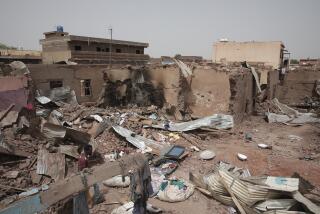War, Famine Threaten Dinka Culture of Southern Sudan
- Share via
WUN ROK, Sudan — Rosario Deng Bek is an anxious man. With four wives and more than 20 children--he’s lost count--Bek, a Dinka from southern Sudan, has many mouths to feed at a time when famine threatens his homeland.
But equally troubling to Bek is the fact that his four unwed daughters may never marry, as few suitors have enough cattle to pay a bride’s dowry, as is Dinka custom.
Long-horned cattle--a symbol of wealth and the centerpiece of many Dinka cultural observances--are being sold for cash, slaughtered for food, stolen in raids, or are simply dying because drought has ruined grazing land.
And a decades-old civil war that pits the mainly Muslim government of the north against primarily Christian black African rebels in the south is exacerbating the Dinka people’s inability to rear their beloved beast--and putting their age-old traditions in peril.
“What I see is the end of the Dinka way of life,” said Diana Cammack, a social researcher who has been studying the behavior of southern Sudan’s predominant ethnic group for the U.N. World Food Program. “Things are changing due to several decades of war, in addition to several years of drought. In between, there have been raids and bombings. What we’re seeing now is a culmination of all this.”
Except for 11 years of relative calm after a 1972 peace agreement, war has racked Sudan--Africa’s largest nation, geographically--since it gained independence in 1956 from joint British and Egyptian rule. The southern rebels are demanding autonomy from the north, exemption from Islamic law and a fair share of development money. An estimated 1.3 million people have died since the modern phase of the war began in 1983.
A recent upsurge in fighting and a dry spell that has ravaged this season’s harvest have put 2.6 million Sudanese, mostly in the southern provinces, in “dire” need of food, the U.N. said Friday.
Villagers living on parched, fly-infested plains have taken to digging up anthills to steal the insects’ minuscule grain supply. Some try to survive on wild and often poisonous berries and on fruit from the tropical tamarind tree.
The World Food Program has received at least $28.5 million for emergency relief, but the U.N. estimates that the cost of feeding Sudan’s starving through next April would total $137 million.
The Sudanese government did recently lift a ban on international aid flights, and the World Food Program announced Friday that it would more than double the amount of food it was airlifting into Sudan.
What worries the Dinka, however, is that they may never be able to repair the severe breakdown in their social structures.
A Good Samaritan tradition that obliged Dinkas to help one another out during hard times has fallen away as families fight for their own survival. Gender roles have been reversed, with unmarried or widowed Dinka men often doing chores, like planting sorghum and fetching water, that are typically considered women’s work.
And local leaders estimate that more than 80% of Dinkas have lost their entire herds of cherished longhorns. Many refugees have been forced to leave their livestock behind. Bek, a former local official in the government-held garrison town of Wau, gave up 50 longhorns and a few goats when he fled a rebel advance in January.
Southern Sudan is also plagued by mounted Arab militia groups known as murhaleen, who terrorize Dinka villages, stealing cattle and abducting women and children.
Despite strong denials by the government, both local and outside observers believe the bandits are paid and armed by the northern regime.
“With the armaments that are now out there, cattle raiding has become a military operation in many cases,” said James Abelee, a U.N. security officer in Kenya.
And those animals that survive starvation and disease are sometimes killed for food.
The cultural toll of the disappearance of Dinka cattle has been immense. The beasts were used in conflict resolution by traditional courts led by elders who would award them as compensation to an aggrieved party. Now this judiciary system has all but crumbled.
A bull might be slaughtered on a significant occasion, such as a wedding or funeral, but the Dinka would rarely kill a cow simply for food. Instead, they preferred to preserve their longhorns, drinking their milk, selling the animals or their progeny for cash, or exchanging them for other commodities.
Even the cattle’s dung is important; set afire, the smoldering excrement is said to be an effective mosquito repellent.
Hunger has also led some Dinkas to commit an unthinkable crime: killing another man’s cattle for food.
And many fathers fear their daughters might be left on the shelf, as few prospective husbands can present a dowry, even though the standard gift has fallen from 100 head of cattle to between 30 and 50.
Even the decision to marry presents a dilemma.
“These days you have to choose,” said Bek. “Either you have a wife without food, or you have food without a wife.”
More to Read
Sign up for Essential California
The most important California stories and recommendations in your inbox every morning.
You may occasionally receive promotional content from the Los Angeles Times.














